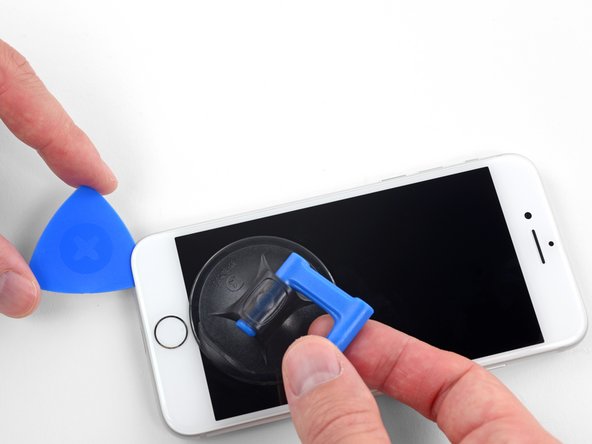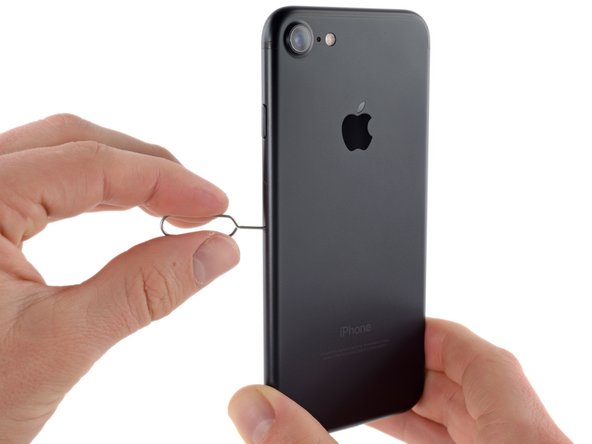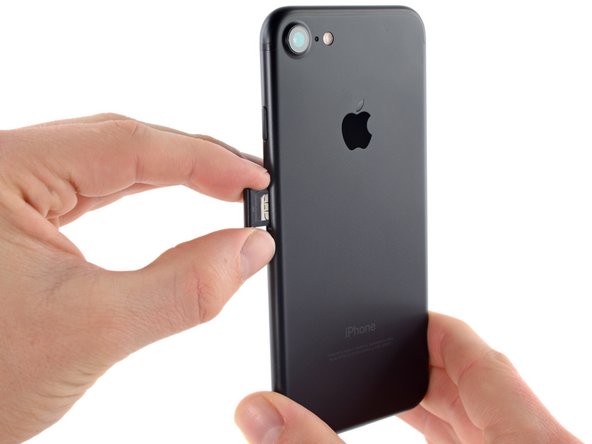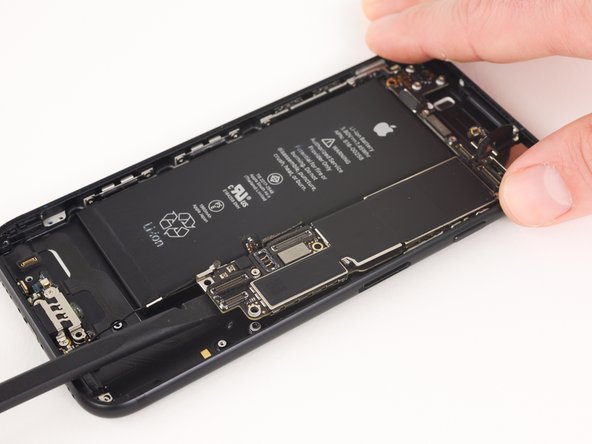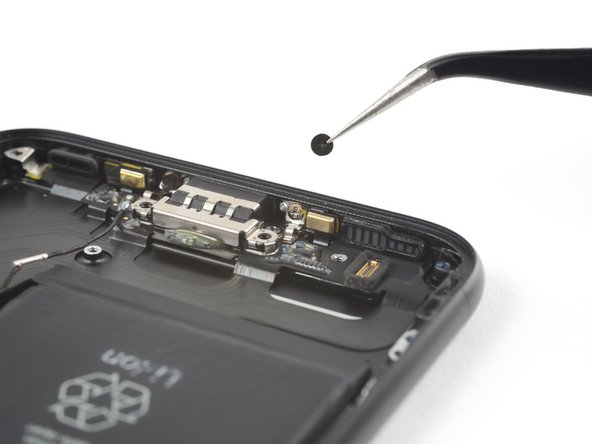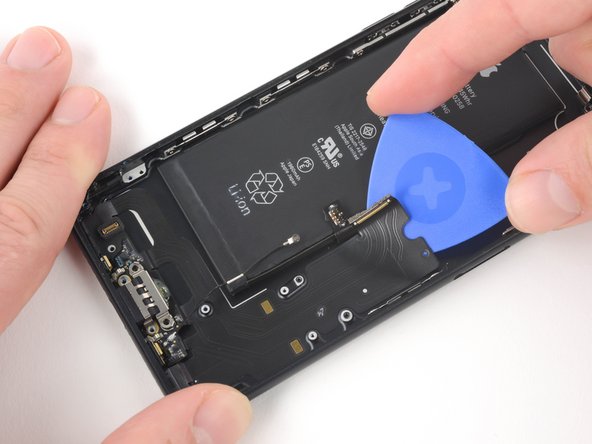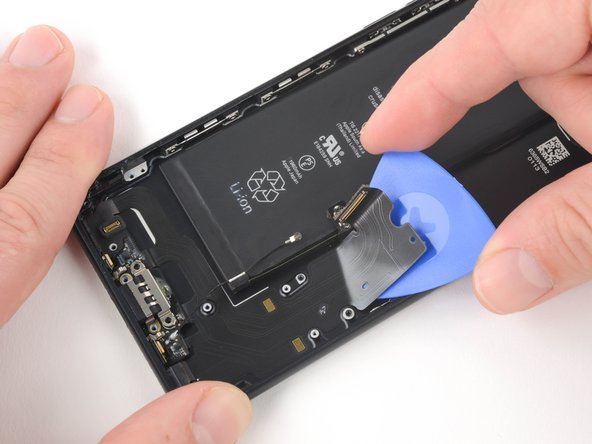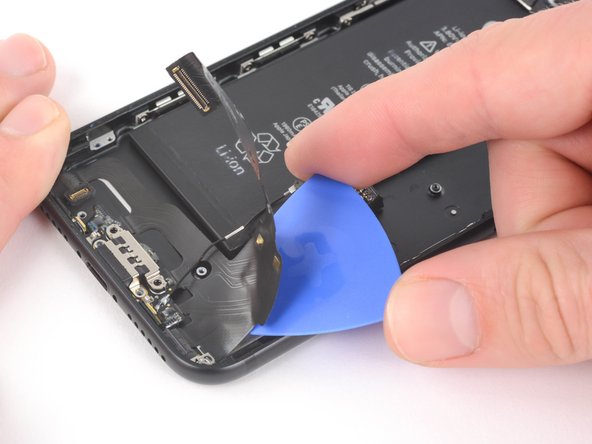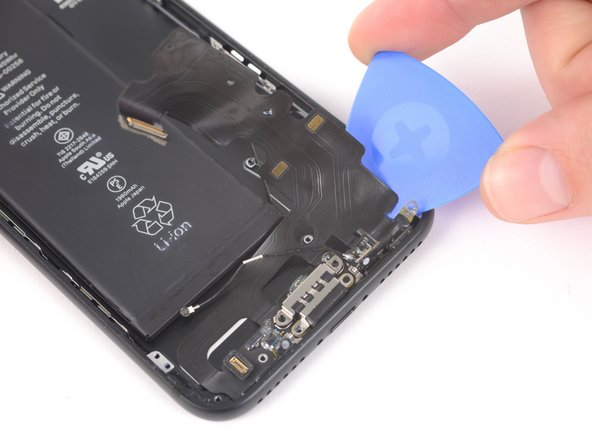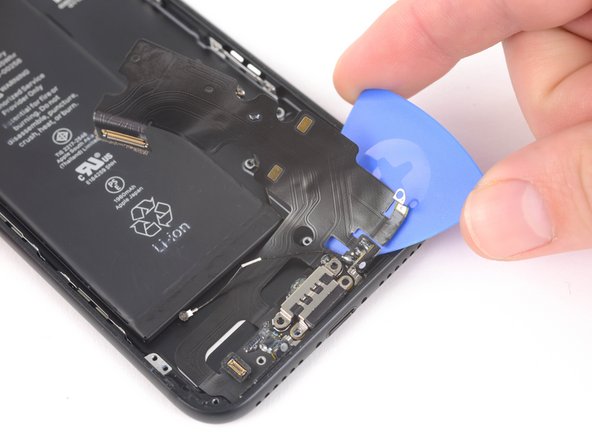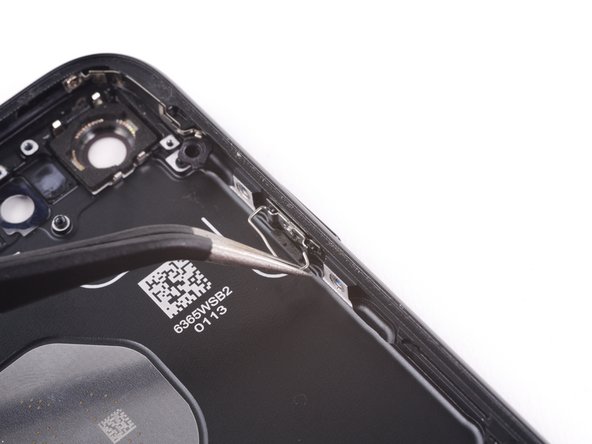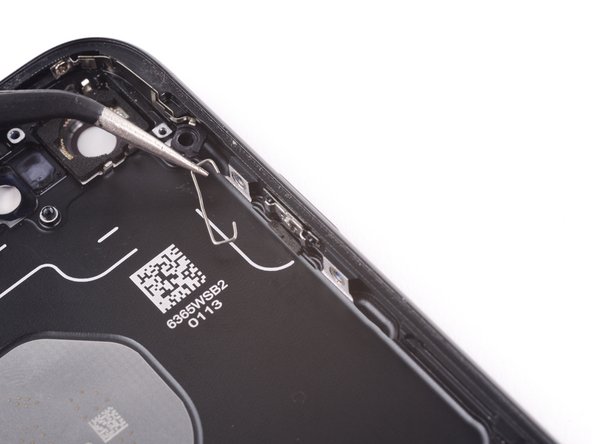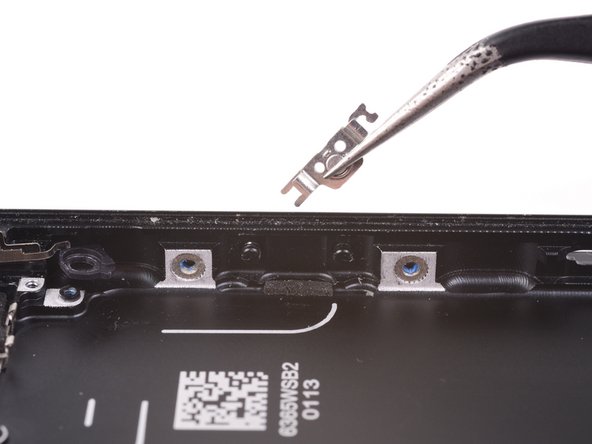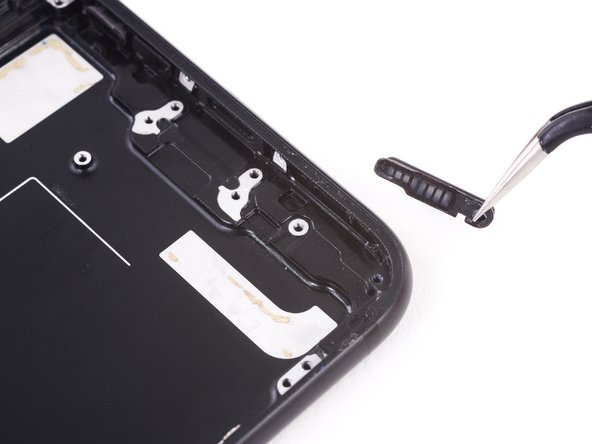Esta versão pode conter edições incorretas. Mude para o último instantâneo verificado.
O que você precisa
-
Este passo não foi traduzido. Ajude a traduzi-lo
-
Power off your iPhone before beginning disassembly.
-
Remove the two 3.4 mm pentalobe screws on the bottom edge of the iPhone.
-
-
-
Meça 3 mm a partir da ponta e marque a palheta com um marcador permanente.
-
-
-
Puxe a pega azul para trás para destravar os braços do Anti-Clamp.
-
Deslize os braços pela borda esquerda ou direita do seu iPhone.
-
Posicione as ventosas próximo à borda inferior do iPhone, diretamente acima do botão home - uma pela dianteira e a outra pela traseira.
-
Aperte as ventosas uma contra a outra para aplicar sucção na área desejada.
-
-
-
Puxe a pega azul para a frente para travar os braços.
-
Gire a pega 360 graus no sentido horário até que as ventosas comecem a se esticar.
-
Certifique-se de que as ventosas permaneçam alinhadas uma com a outra. Se elas começarem a ficar desalinhadas, solte um pouco as ventosas e realinhe os braços.
-
-
-
Aqueça uma bolsa térmica iOpener e passe-a pelos braços do Anti-Clamp.
-
Dobre a bolsa térmica iOpener de modo que ela fique sobre a borda inferior do iPhone.
-
Aguarde um minuto para que o adesivo tenha a chance de se soltar e apresentar um vão para a abertura.
-
Insira uma palheta de abertura no vão.
-
Pule as próximas três etapas.
-
-
-
O aquecimento da borda inferior do iPhone ajudará a amolecer o adesivo que prende a tela, facilitando a abertura.
-
Use um secador de cabelo ou prepare uma bolsa térmica iOpener e aplique-o(a) na borda inferior do iPhone por cerca de 90 segundos para amolecer o adesivo que se encontra por baixo.
-
-
-
Aplique uma ventosa de sucção na metade inferior do painel dianteiro, imediatamente acima do botão home.
-
-
Este passo não foi traduzido. Ajude a traduzi-lo
-
Remove four tri-point Y000 screws securing the lower connector bracket, of the following lengths:
-
Three 1.2 mm screws
-
One 2.4 mm screw
-
-
Este passo não foi traduzido. Ajude a traduzi-lo
-
Use the point of a spudger to lift the battery connector out of its socket on the logic board.
-
-
Este passo não foi traduzido. Ajude a traduzi-lo
-
Use a spudger or a fingernail to disconnect the two lower display connectors by prying them straight up from their sockets on the logic board.
-
-
Este passo não foi traduzido. Ajude a traduzi-lo
-
Remove the two 1.3 mm Phillips #000 screws securing the bracket over the front panel sensor assembly connector.
-
-
Este passo não foi traduzido. Ajude a traduzi-lo
-
Disconnect the front panel sensor assembly connector from its socket on the logic board.
-
-
Este passo não foi traduzido. Ajude a traduzi-lo
-
Remove the two 1.9 mm Phillips screws securing the barometric vent to the rear case.
-
-
Este passo não foi traduzido. Ajude a traduzi-lo
-
Use the flat end of a spudger to disconnect the Taptic Engine connector from its socket on the logic board.
-
-
Este passo não foi traduzido. Ajude a traduzi-lo
-
Remove the three 1.6 mm Phillips screws securing the Taptic Engine to the rear case.
-
-
Este passo não foi traduzido. Ajude a traduzi-lo
-
Remove the Phillips screw securing the Wi-Fi diversity antenna to the rear case:
-
One 3.2 mm screw
-
-
Este passo não foi traduzido. Ajude a traduzi-lo
-
Remove the following three Phillips screws securing the speaker to the rear case:
-
Two 1.3 mm screws
-
One 2.0 mm screw
-
-
Este passo não foi traduzido. Ajude a traduzi-lo
-
Use the point of a spudger to lift the two antenna cable connectors up off of the sockets on the logic board.
-
-
Este passo não foi traduzido. Ajude a traduzi-lo
-
Use tweezers to derout the antenna cables from their bracket on the logic board.
-
-
Este passo não foi traduzido. Ajude a traduzi-lo
-
Use tweezers to remove the antenna cables from the clip on the speaker.
-
-
Este passo não foi traduzido. Ajude a traduzi-lo
-
Use the tip of a spudger to slide the speaker assembly towards the logic board and off of the rear case.
-
-
Este passo não foi traduzido. Ajude a traduzi-lo
-
Insert a SIM card eject tool or a paperclip into the small hole in the SIM card tray.
-
Press to eject the tray.
-
Remove the SIM card tray assembly from the iPhone.
-
-
Este passo não foi traduzido. Ajude a traduzi-lo
-
Use the flat end of a spudger to disconnect the rear-facing camera connector.
-
-
-
Este passo não foi traduzido. Ajude a traduzi-lo
-
Remove the following Phillips screws securing the rear camera bracket to the rear case:
-
One 1.3 mm screw
-
One 2.5 mm screw
-
-
Este passo não foi traduzido. Ajude a traduzi-lo
-
Use the pointed end of a spudger to pry up and disconnect the antenna bus connector, just left of the rear camera module.
-
-
Este passo não foi traduzido. Ajude a traduzi-lo
-
Remove the two 1.2 mm tri-point screws securing the upper cable bracket.
-
-
Este passo não foi traduzido. Ajude a traduzi-lo
-
Use the flat end of a spudger to disconnect the upper cable connector.
-
-
Este passo não foi traduzido. Ajude a traduzi-lo
-
Remove the four Phillips screws securing the Wi-Fi antenna:
-
Three 1.2 mm screws
-
One 1.7 mm screw
-
-
Este passo não foi traduzido. Ajude a traduzi-lo
-
Remove the following Phillips screws:
-
One 1.3 mm screw
-
One 2.2 mm screw
-
-
Este passo não foi traduzido. Ajude a traduzi-lo
-
Remove the 2.2 mm standoff screw from the grounding bracket.
-
-
Este passo não foi traduzido. Ajude a traduzi-lo
-
Use tweezers to gently bend the logic board grounding bracket out of the way.
-
-
Este passo não foi traduzido. Ajude a traduzi-lo
-
Use the point of a spudger to disconnect the lower cable connector.
-
-
Este passo não foi traduzido. Ajude a traduzi-lo
-
Remove the following screws:
-
One 1.4 mm Phillips screw
-
Three 2.2 mm standoff screws
-
In a pinch, a small flathead screwdriver will do the job—but use extra caution to ensure it doesn't slip and damage surrounding components.
-
-
Este passo não foi traduzido. Ajude a traduzi-lo
-
Use the point of a spudger to move the SIM card eject plunger out of the logic board's way.
-
-
Este passo não foi traduzido. Ajude a traduzi-lo
-
Use the flat end of a spudger to gently lift the battery connector end of the logic board up.
-
-
Este passo não foi traduzido. Ajude a traduzi-lo
-
Lift the battery connector end of the logic board and pull it up and out of the rear case.
-
-
Este passo não foi traduzido. Ajude a traduzi-lo
-
Remove the 2.9 mm Phillips screw from the lightning connector.
-
-
Este passo não foi traduzido. Ajude a traduzi-lo
-
Remove the spring contact from the lightning connector.
-
-
Este passo não foi traduzido. Ajude a traduzi-lo
-
Remove the two 1.6 mm Phillips screws securing the lightning connector cable in place.
-
-
Este passo não foi traduzido. Ajude a traduzi-lo
-
Remove the two stickers covering the screws that secure the lightning connector to the bottom of the rear case.
-
-
Este passo não foi traduzido. Ajude a traduzi-lo
-
Remove the two 1.3 mm Phillips screws from the rear case.
-
-
Este passo não foi traduzido. Ajude a traduzi-lo
-
Use the pointed end of a spudger to separate the two microphones from the bottom of the rear case.
-
-
Este passo não foi traduzido. Ajude a traduzi-lo
-
Use a hairdryer or reheat your iOpener to heat the lower edge of the phone.
-
Wait for about a minute, allowing the adhesive to warm up before proceeding to the next step.
-
-
Este passo não foi traduzido. Ajude a traduzi-lo
-
Starting from the middle of the phone, slide an opening pick underneath the lightning connector to separate it from the rear case.
-
-
Este passo não foi traduzido. Ajude a traduzi-lo
-
Continue to slide the pick towards the lightning connector to further separate the assembly from the rear case.
-
-
Este passo não foi traduzido. Ajude a traduzi-lo
-
Continue to slide the pick underneath the lightning connecter assembly.
-
Stop sliding the pick once it passes the battery.
-
-
Este passo não foi traduzido. Ajude a traduzi-lo
-
Starting at the corner of the phone, slide the pick underneath the assembly towards the lightning connector.
-
Stop sliding the pick when it reaches the lightning connector.
-
-
Este passo não foi traduzido. Ajude a traduzi-lo
-
Gently pull the lightning connector out of its hole on the rear case.
-
-
Este passo não foi traduzido. Ajude a traduzi-lo
-
Slide a pick below the lightning connector to further separate the lightning connector assembly from the rear case.
-
Continue to slide the pick until the lightning connector assembly is no longer adhered to the rear case.
-
-
Este passo não foi traduzido. Ajude a traduzi-lo
-
Remove the lightning connector assembly.
-
Use a plastic tool to scour any bits of adhesive residue from the rear case.
-
Make sure the Lightning connector assembly is correctly positioned so that the two white dots on the iPhone's rear case show through the two circular cutouts in the Lightning flex cable. If they don't, the flex cable will remain misaligned and you won't be able to reconnect it to its socket on the logic board.
-
-
Este passo não foi traduzido. Ajude a traduzi-lo
-
Use a pair of tweezers with blunt tips to peel back one of the adhesive strips on the lower edge of the battery.
-
-
Este passo não foi traduzido. Ajude a traduzi-lo
-
Use a pair of tweezers with blunt tips to peel back the other adhesive strip on the lower edge of the battery.
-
-
Este passo não foi traduzido. Ajude a traduzi-lo
-
Slowly pull one battery adhesive tab away from the battery, toward the bottom of the iPhone.
-
Pull steadily, maintaining constant tension on the strip until it slips out from between the battery and the rear case. For best results, pull the strip at a 60º angle or less.
-
-
Este passo não foi traduzido. Ajude a traduzi-lo
-
Repeat the previous step for the second strip.
-
If you removed both adhesive strips successfully, skip the next step.
-
Otherwise, if either of the adhesive strips broke off underneath the battery and could not be retrieved, continue with the next step below.
-
-
Este passo não foi traduzido. Ajude a traduzi-lo
-
Prepare an iOpener and apply it to the back of the rear case, directly over the battery. Alternatively, you can apply heat using a heat gun or hair dryer.
-
After about a minute, remove the iOpener, flip the phone over and use a plastic card to break up any remaining adhesive behind the battery.
-
-
Este passo não foi traduzido. Ajude a traduzi-lo
-
Remove the following Phillips screws:
-
Two 1.9 mm screws securing the power button.
-
Three 2.3 mm screws securing the volume buttons.
-
-
Este passo não foi traduzido. Ajude a traduzi-lo
-
Remove the following 1.3 mm Phillips screws:
-
One screw beside the rear-facing camera
-
One screw on the rear case
-
-
Este passo não foi traduzido. Ajude a traduzi-lo
-
From the outside of the phone, push the hold switch into the rear case with the point of a spudger.
-
This action will free the hold switch and gasket from the rear case.
-
-
Este passo não foi traduzido. Ajude a traduzi-lo
-
Use a pair of tweezers to remove the rear-facing camera.
-
-
Este passo não foi traduzido. Ajude a traduzi-lo
-
Moving from power button side of the phone, use an opening pick to separate the adhesive holding the antenna flex cable to the rear case.
-
-
Este passo não foi traduzido. Ajude a traduzi-lo
-
Slide the point of an opening pick underneath the antenna flex cable towards the top of the phone, separating the remaining adhesive.
-
-
Este passo não foi traduzido. Ajude a traduzi-lo
-
Use tweezers to move the antenna flex cable away from the edge of the phone, freeing the screw bracket from the rear case.
-
Remove the antenna flex cable.
-
-
Este passo não foi traduzido. Ajude a traduzi-lo
-
Remove the 2.3 mm standoff screw securing the flash bracket to the rear case.
-
-
Este passo não foi traduzido. Ajude a traduzi-lo
-
Use the point of a spudger to gently unseat the flash module.
-
-
Este passo não foi traduzido. Ajude a traduzi-lo
-
Use the blade of a Halberd spudger to separate the adhesive holding the microphone to the rear case.
-
-
Este passo não foi traduzido. Ajude a traduzi-lo
-
Gently fold the power button module from the edge of the rear case.
-
-
Este passo não foi traduzido. Ajude a traduzi-lo
-
Slide the blade of a halberd spudger under the power button end of the button cable to separate it from the adhesive on the rear case.
-
Continue to separate the adhesive by moving the blade towards the top of the phone.
-
-
Este passo não foi traduzido. Ajude a traduzi-lo
-
Continue to move the blade of the halberd spudger underneath the power and volume control cable.
-
-
Este passo não foi traduzido. Ajude a traduzi-lo
-
Slide the halberd spudger under the volume control portion of the button cable.
-
Gently slide the blade underneath the cable towards the bottom of the phone, separating the remaining adhesive.
-
-
Este passo não foi traduzido. Ajude a traduzi-lo
-
Pull the clip towards the bottom of the phone and lift up to free it from the bracket.
-
-
Este passo não foi traduzido. Ajude a traduzi-lo
-
Push the lower end of the power button bracket up off of peg securing it.
-
-
Este passo não foi traduzido. Ajude a traduzi-lo
-
Use the pointed end of a spudger to push the power button cover out of the rear case.
-
Remove the power button cover.
-
-
Este passo não foi traduzido. Ajude a traduzi-lo
-
Pull the volume button clip towards the bottom of the phone to free it from the bracket.
-
-
Este passo não foi traduzido. Ajude a traduzi-lo
-
Pull the clip towards the top of the phone to remove it.
-
-
Este passo não foi traduzido. Ajude a traduzi-lo
-
Pull the volume button clip towards the bottom of the phone to free it from the bracket.
-
Pull the clip towards the top of the phone to remove it.
-
-
Este passo não foi traduzido. Ajude a traduzi-lo
-
Slide the flat end of a spudger underneath the bottom edge of the volume button bracket.
-
Adjust the spudger so that it can move away from the rear case without contacting the protruding peg that is on the volume button.
-
Rotate the spudger to pop the bracket off of the peg on the volume button.
-
-
Este passo não foi traduzido. Ajude a traduzi-lo
-
Repeat the procedure to remove the second volume button bracket.
-
-
Este passo não foi traduzido. Ajude a traduzi-lo
-
Use the pointed end of a spudger to push each of the volume button covers out of the rear case.
-
Remove the volume button covers.
-
-
Este passo não foi traduzido. Ajude a traduzi-lo
-
Use the point of a spudger to push the left rubber speaker vent out of the rear case.
-
-
Este passo não foi traduzido. Ajude a traduzi-lo
-
Remove the right rubber speaker vent from the rear case.
-
-
Este passo não foi traduzido. Ajude a traduzi-lo
-
Remove the 1.5 mm Phillips screw securing the grounding bracket.
-
Cancelar: não concluí este guia.
71 outras pessoas executaram este guia.
10 comentários
Great Guide!
There are some components that may need to be transferred to your new case, which are not in this guide:
1 speaker screens
2 screen mounting catches
3 put the SIM card tray ejector pin back in BEFORE the logic board. I inserted it before mounting the logic board, otherwise the pin may fall out.
Hello everyone!
Has anyone had problems with reception, especially the 4G network, after replacing the body with a non-original one?
thank you and sorry for my terrible english!
Merci tres bon tutoriel tout c’est bien passé
HIW much cost to changing it


















